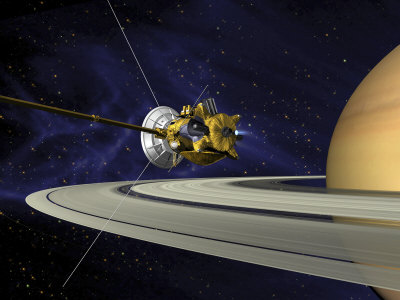Jupiter and Saturn -- Spectacular Planets
Look to the east this month and you will notice two bright star-like
objects. Except they are not stars at all, but the two largest planets
in the Solar System--Jupiter and Saturn. Both planets appear brighter
than they have for many years.
Jupiter is the largest of the nine planets in the Solar System. At its
equator it has a diameter of 143,000 kilometers which is about 11 times
wider than Earth. In fact Jupiter is so large that it weighs over twice
as much as all the other planets put together. Not satisfied at being
the heavyweight of the Solar System, Jupiter also spins on its axis
faster than any other planet--one complete rotation takes just 9 hours
and 50 minutes. Because of this high rotation speed a telescope shows
Jupiter's disc as elliptical--like a slightly squashed circle, wider
across its equator than from pole-to-pole.
A look through a small telescope will reveal that the surface of Jupiter
is covered with swirling, banded clouds. Beneath the clouds the planet
is known to be mainly made up of liquid hydrogen and helium. A telescope
or powerful binoculars will also show what appears to be up to four
"stars" lined up on either side of the giant planet. But, don't be
fooled, they are not stars but Jupiter's largest moons first seen by
Galileo Galilei in 1610. Observe the moons of Jupiter a few hours apart
and you will notice a change in their relative positions.
The planet Saturn is a gas giant planet similar to Jupiter. It too has a
cloudy atmosphere with an interior of liquid hydrogen and helium.
However, the feature that makes Saturn famous is the magnificent ring
system that encircles its equator. The broad rings are known to be made
up of icy lumps no larger than a few meters across.

Click Here for Information or to Buy this Premium Poster
The Cassini spacecraft, currently on its way to Saturn, will perform the
most detailed survey to date of the ringed-planet. Cassini is due to fly
past Jupiter on December 30 this year. It will use the giant planet's
gravity to bend its flight path to put it on course for arrival into
orbit around Saturn on July 1, 2004.
A view of Saturn and its rings through a telescope is one of the most
spectacular sights in the entire night sky. Contact your local astronomy
club to find out about their next viewing night. It's worth the effort
just to see Jupiter and Saturn through a telescope.
Finally, look out for Venus low in the southwest. Clear skies till next
month!
Related Links:
Related Books:


